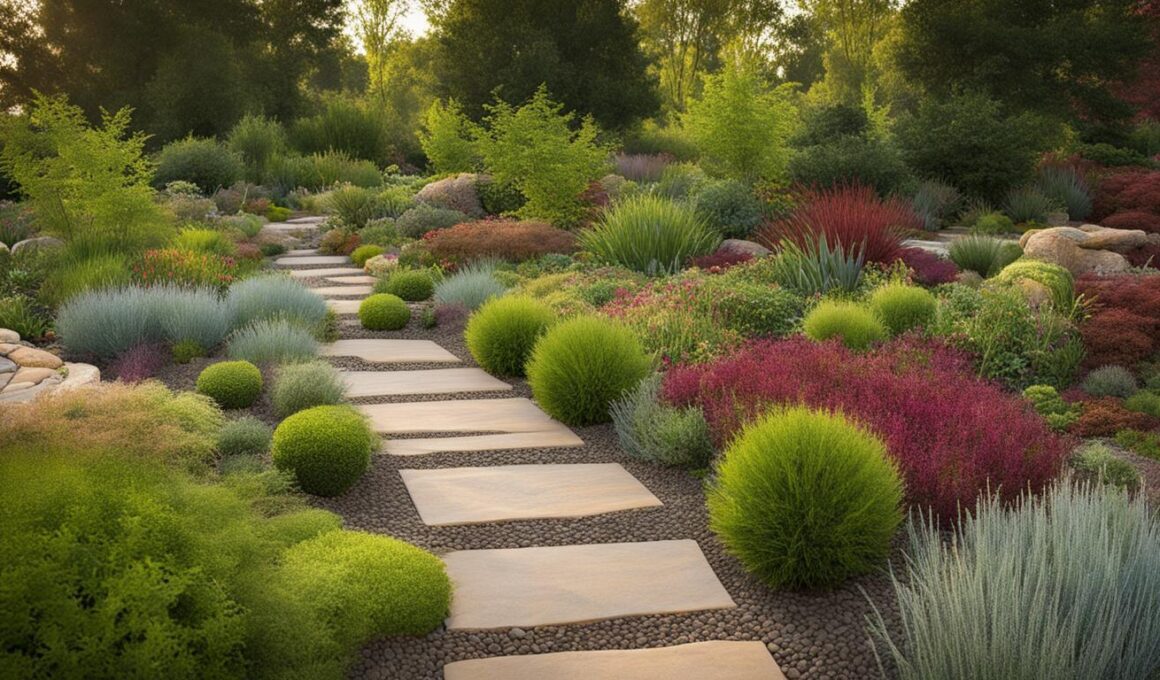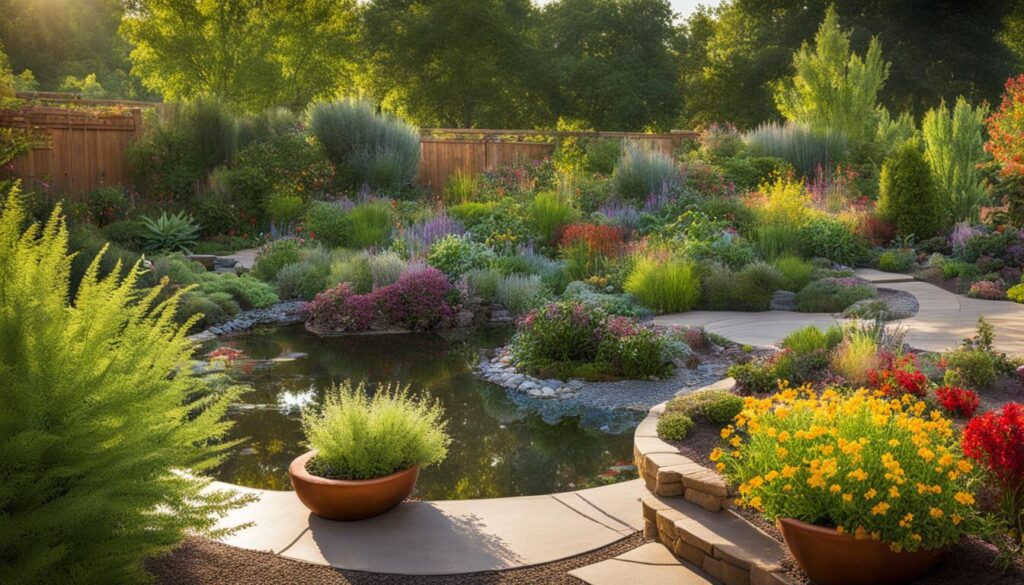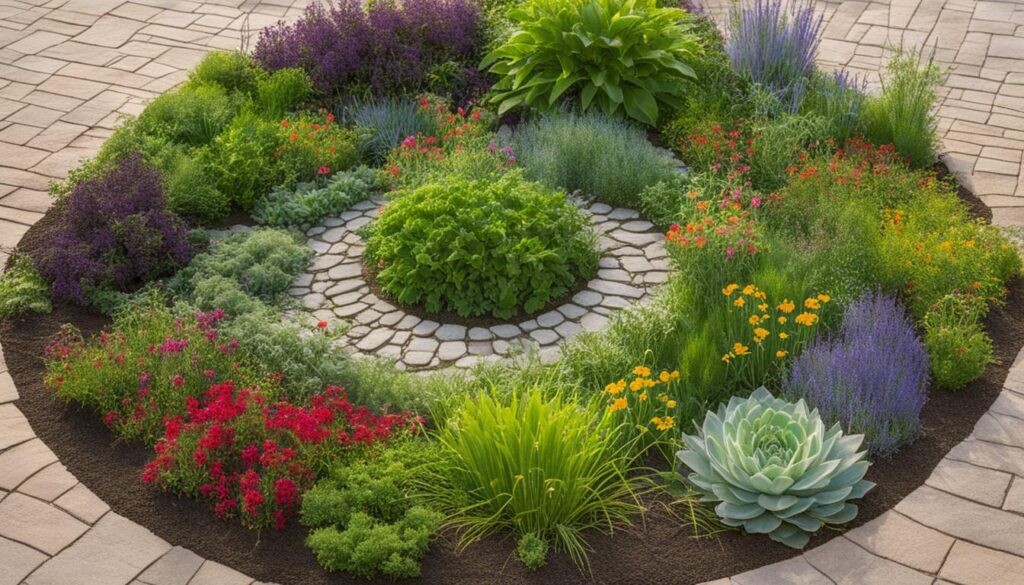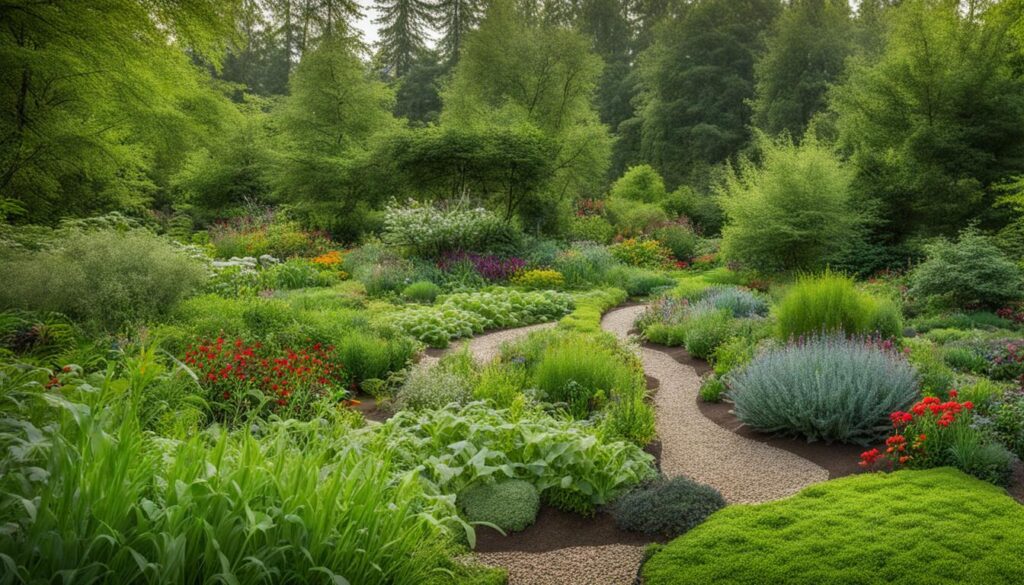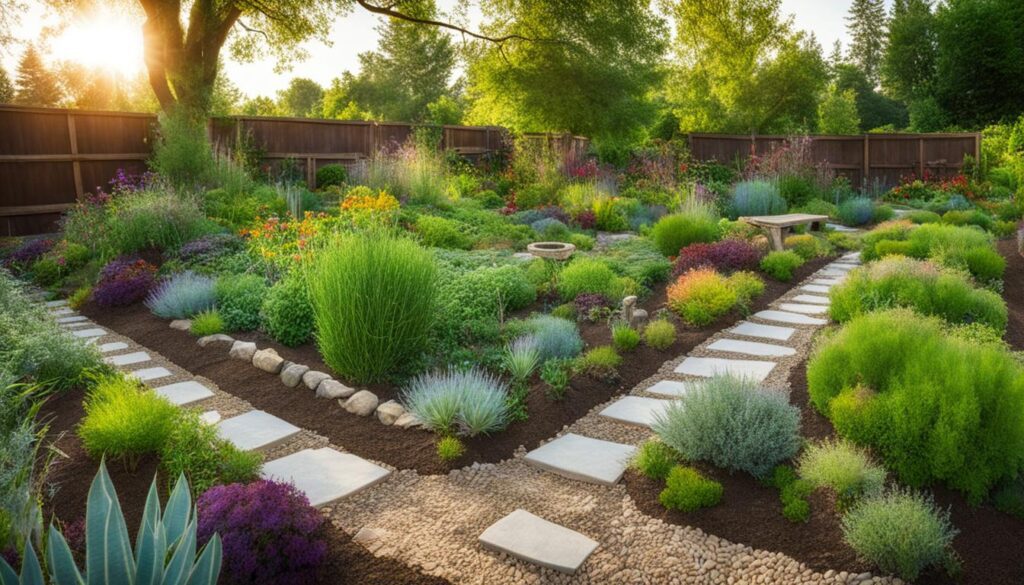Permaculture is an approach to design that mimics natural ecologies and promotes sustainability. It focuses on principles such as care for the Earth, care for people, and sharing surplus. Xeriscape principles aim to conserve water in landscaping. By integrating permaculture with xeriscape principles, you can create a landscape that is sustainable, saves water, and supports ecological balance.
Key Takeaways:
- Integrating permaculture with xeriscape principles can create a sustainable landscape that saves water.
- Permaculture design focuses on mimicking natural ecologies and promoting sustainability.
- Xeriscape principles aim to conserve water in landscaping.
- By applying permaculture principles to landscape design and gardening, you can create an interconnected and productive environment.
- Integrating permaculture and xeriscape principles offers numerous benefits for sustainable landscaping, including water conservation and improved ecological balance.
What is Permaculture Design?
Permaculture design, coined by Bill Mollison in the 1970s, is a holistic approach to sustainable living that aims to mimic natural ecosystems. It addresses the destructive methods of modern food production and distribution by creating self-sustainable agricultural systems through smart design principles. Permaculture can be implemented in any ecological system, including high desert environments.
Water plays a critical role in permaculture design, especially in desert landscapes. Successful implementation of permaculture in the desert requires a sustainable cycle where water is effectively managed and conserved within the system. By understanding the principles of permaculture design, you can create landscapes that are not only sustainable but also thrive in challenging environments.
“Permaculture is a philosophy of working with, rather than against nature; of protracted and thoughtful observation rather than protracted and thoughtless labor; and of looking at plants and animals in all their functions, rather than treating any area as a single product system.” – Bill Mollison
Permaculture design focuses on creating ecosystems that are productive, resilient, and in harmony with nature. It emphasizes observing and interacting with nature, using and valuing renewable resources, and obtaining a yield. By applying permaculture design principles, you can create sustainable agricultural systems, reduce waste, and promote ecological balance.
The Principles of Permaculture Design
Permaculture design is guided by 12 principles that were defined by David Holmgren in his book “Permaculture: Principles and Pathways Beyond Sustainability”. These principles provide a framework for creating sustainable systems and can be applied to various aspects of life, including landscape design, gardening, and food preservation.
- Observe and interact with nature: Understanding the patterns and functions of ecosystems is key to designing sustainable systems.
- Catch and store energy: Utilize renewable resources and find ways to harness and store energy for future use.
- Obtain a yield: Design productive systems that provide a surplus, whether it’s food, energy, or other resources.
- Apply self-regulation and accept feedback: Create systems that can adapt and self-regulate based on feedback from the environment.
- Use and value renewable resources and services: Emphasize the importance of utilizing renewable resources and supporting natural processes.
- Produce no waste: Aim to minimize waste and create closed-loop systems that recycle and reuse resources.
- Design from patterns to details: Start with understanding the larger patterns and relationships, then focus on the specifics of the design.
- Integrate rather than segregate: Seek opportunities to integrate different elements and functions to create a more resilient and diverse system.
- Use small and slow solutions: Start small and gradually expand, allowing time for observation and adjustment.
- Use and value diversity: Embrace diversity in all aspects of design, including species, functions, and strategies.
- Use edges and value the marginal: Maximize edge effects and utilize the edge spaces, which often have unique characteristics and opportunities.
- Creatively use and respond to change: Embrace change as an opportunity for creativity and innovation, designing systems that can adapt to changing conditions.
By incorporating these principles into your permaculture design, you can create sustainable and efficient systems that benefit both the environment and human well-being.
The 12 Principles of Permaculture
In the world of permaculture design, there are twelve fundamental principles that serve as guiding lights for creating sustainable systems. These principles, as defined by David Holmgren in his book “Permaculture: Principles and Pathways Beyond Sustainability,” provide a framework for designing and maintaining ecological harmony. By incorporating these principles into your landscape design, gardening practices, and even food preservation, you can contribute to a more sustainable and efficient system.
- Observe and interact: One of the core principles of permaculture is to take the time to observe and interact with nature. By understanding the patterns and processes of the natural world, you can design systems that work in harmony with the environment.
- Use and value renewable resources and services: Permaculture emphasizes the importance of utilizing renewable resources and services, such as solar energy, wind power, and nutrient cycling. By valuing these resources, we can minimize waste and create self-sustaining systems.
- Obtain a yield: In permaculture, every element within a system should have a purpose and provide a yield. Whether it’s food, energy, or materials, obtaining a yield ensures that each component contributes to the overall system’s productivity.
- Apply self-regulation and accept feedback: Just as natural systems self-regulate and adapt to feedback, permaculture designs should also incorporate this principle. By continuously monitoring and adjusting our systems, we can respond to changes and maintain their long-term health and resilience.
- Use and value diversity: Diversity is critical for fostering resilient and productive ecosystems. By embracing a variety of plants, animals, and microorganisms, permaculture designs can harness the benefits of diversity, such as pest control, nutrient cycling, and increased resilience to environmental stressors.
- Use edges and value the marginal: The edges between different ecosystems often harbor unique opportunities and resources. Permaculture designs seek to maximize the potential of these edges and value the often-overlooked marginal spaces.
- Creatively use and respond to change: Change is inevitable, and permaculture designs embrace this reality. By creatively adapting to changes, whether natural or human-induced, we can transform challenges into opportunities and foster resilience within our systems.
- Integrate rather than segregate: In permaculture, diversity is not only celebrated within individual elements but also across the entire system. By integrating different components and functions, we can create mutually beneficial relationships that enhance the overall efficiency and productivity of the system.
- Use small and slow solutions: Permaculture designs prioritize small-scale, thoughtful interventions over large-scale, quick fixes. By starting small and observing the results, we can avoid unintended consequences and develop more effective long-term solutions.
- Use and value renewable resources and services: Permaculture emphasizes the importance of utilizing renewable resources and services, such as solar energy, wind power, and nutrient cycling. By valuing these resources, we can minimize waste and create self-sustaining systems.
“Permaculture is about saving the planet and living to be a hundred, while throwing very impressive dinner parties and organizing other creatures to do most of the work.” – David Holmgren
By incorporating these twelve principles into our lives and landscapes, we can create sustainable systems that not only benefit ourselves but also contribute to the well-being of our planet. Whether you’re designing a garden, building a community, or reimagining your entire lifestyle, permaculture offers a holistic approach to creating a more sustainable and regenerative future.
Applying Permaculture Design Principles to Landscape Design
In landscape design, incorporating permaculture design principles can result in a transformative and sustainable environment. By integrating these principles, you can create a landscape that supports ecological balance, maximizes productivity, and conserves resources. Let’s explore how you can apply permaculture design principles to landscape design.
Observe and Interact: Understanding the Site
The first step in applying permaculture design principles to landscape design is to observe and interact with the site. This involves studying the existing conditions such as sunlight exposure, soil quality, and water availability. By understanding the unique characteristics of your site, you can make informed decisions and design a landscape that complements the natural environment.
Catch and Store Energy: Utilizing Renewable Resources
Another key principle is to catch and store energy. In landscape design, this can be achieved by harnessing renewable resources such as sunlight, wind, and rainwater. Incorporating features like solar panels, wind turbines, and rainwater harvesting systems can help reduce energy consumption and create a more self-sustaining landscape.
Obtain a Yield: Creating an Edible Landscape
One of the exciting aspects of permaculture design principles is the ability to create an edible landscape. By integrating fruit trees, vegetable gardens, and edible plants into your landscape design, you can obtain a yield of fresh, organic produce. This not only adds beauty to your landscape but also provides a source of nutritious food for you and your family.
Integrating Permaculture and Xeriscape Principles in Gardening
Gardening is not just about growing plants; it is about creating an ecosystem that thrives in harmony with nature. By integrating permaculture and xeriscape principles into your gardening practices, you can take your sustainable gardening to the next level.
Permaculture principles emphasize observation, interaction, and obtaining a yield. By observing and interacting with your garden, you can better understand its unique characteristics and design a space that maximizes its potential. Catching and storing energy, such as harnessing the sun’s power through solar panels or utilizing wind energy, can help reduce your ecological footprint.
Xeriscape principles, on the other hand, focus on water conservation. By incorporating drought-tolerant plants, mulching, and efficient irrigation systems, you can minimize water waste and create a garden that thrives with minimal water usage. This not only benefits the environment but also reduces your water bill.
“Integrating permaculture and xeriscape principles in gardening can revolutionize your approach to sustainable gardening.”
Benefits of Integrating Permaculture and Xeriscape Principles in Gardening
- Water conservation: By practicing xeriscape techniques, you can significantly reduce water consumption in your garden.
- Sustainability: Permaculture principles help create a self-sustaining ecosystem that reduces reliance on external resources.
- Biodiversity: By designing your garden to mimic natural ecosystems, you can attract diverse wildlife and promote biodiversity.
- Low maintenance: Integrating permaculture and xeriscape principles minimizes the need for excessive maintenance, saving you time and effort.
- Resilience: A garden designed with these principles in mind is more resilient to climate variations and other environmental challenges.
Integrating permaculture and xeriscape principles in gardening not only benefits the environment but also enhances your gardening experience. It allows you to create a sustainable and beautiful garden that supports local flora and fauna while conserving precious resources like water. Start implementing these principles in your garden today and make a positive impact on the planet.
Benefits of Integrating Permaculture With Xeriscape Principles
Integrating permaculture with xeriscape principles offers a multitude of benefits for sustainable landscaping. By combining these two approaches, you can create a landscape that not only conserves water but also promotes ecological balance and resilience. Here are some key benefits of integrating permaculture with xeriscape principles:
1. Water Conservation:
One of the primary benefits of integrating permaculture with xeriscape principles is water conservation. Xeriscape techniques such as using drought-tolerant plants, mulching, and efficient irrigation systems can significantly reduce water usage in your landscape. By incorporating permaculture design principles that focus on water catchment, storage, and reuse, you can further enhance water conservation efforts, making your landscape more sustainable and resilient in times of drought.
2. Ecological Balance:
Integrating permaculture with xeriscape principles can help restore and maintain ecological balance in your landscape. Permaculture design principles prioritize working with nature rather than against it, promoting biodiversity and creating habitats for beneficial insects, birds, and wildlife. By selecting native and regionally adapted plants and implementing permaculture techniques such as soil building and natural pest control, you can create a healthy and thriving ecosystem that supports the overall ecological balance of your landscape.
3. Soil Health and Fertility:
Another benefit of integrating permaculture with xeriscape principles is improved soil health and fertility. Permaculture emphasizes the importance of building and nurturing healthy soil, which is the foundation for a productive and resilient landscape. By incorporating practices such as composting, cover cropping, and organic mulching, you can enrich the soil with organic matter, improve its water-holding capacity, and enhance nutrient availability for plants. This leads to healthier, more robust plant growth and reduces the need for synthetic fertilizers, further contributing to the sustainability of your landscape.
Integrating permaculture with xeriscape principles in your landscape design offers numerous benefits that go beyond water conservation. By creating a landscape that promotes ecological balance, enhances soil health, and maximizes resource efficiency, you are not only reducing your environmental impact but also creating a beautiful and sustainable outdoor space. Whether you are a homeowner, a landscape designer, or a gardener, incorporating permaculture and xeriscape principles can transform the way you approach landscaping and contribute to a more sustainable future.
How Can Permaculture Principles Be Incorporated into Xeriscaping for Water Conservation?
When incorporating xeriscaping water conservation techniques into landscaping, permaculture principles can be utilized to create a sustainable and water-wise environment. By promoting biodiversity, capturing and storing water, and promoting healthy soil, xeriscaping can not only conserve water but also promote ecological balance and resilience.
Conclusion
Integrating Permaculture with Xeriscape Principles is a game-changer for sustainable landscaping and water conservation. By incorporating the design principles of Permaculture and employing Xeriscape techniques, you can transform your landscape into a visually stunning, water-efficient, and ecologically balanced oasis. Whether you are working on a small garden or a large-scale landscape project, this integration can revolutionize the way you approach landscaping and contribute to a more sustainable future.
By implementing Permaculture design principles, such as observing and interacting with nature, catching and storing energy, and obtaining a yield, you create a landscape that thrives on its own without the need for excessive inputs. Pairing these principles with Xeriscape techniques, like using drought-tolerant plants, mulching, and efficient irrigation systems, further enhances water conservation and sustainability.
The benefits of integrating Permaculture with Xeriscape Principles are vast. Not only do you conserve water by utilizing efficient irrigation systems and drought-tolerant plants, but you also promote ecological balance, enhance biodiversity, and improve soil health. Additionally, following these principles reduces maintenance needs, saves water and energy, and ultimately results in a landscape that is not only beautiful but also sustainable.
So, whether you’re a homeowner looking to transform your backyard, a landscape designer working on a community project, or a farmer aiming to create a regenerative agricultural system, integrating Permaculture with Xeriscape Principles is the way forward. Embrace this powerful approach and contribute to a greener, more sustainable landscape that thrives while conserving precious water resources.





